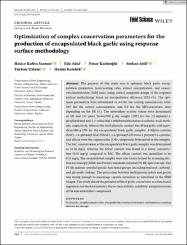| dc.contributor.author | Şasmaz, Hatice Kübra | |
| dc.contributor.author | Adal, Eda | |
| dc.contributor.author | Kadiroğlu, Pınar | |
| dc.contributor.author | Selli, Serkan | |
| dc.contributor.author | Uzlaşır, Türkan | |
| dc.contributor.author | Kelebek, Haşim | |
| dc.date.accessioned | 2024-01-16T06:45:02Z | |
| dc.date.available | 2024-01-16T06:45:02Z | |
| dc.date.issued | 2023 | en_US |
| dc.identifier.citation | Sasmaz, H.K., Adal, E., Kadiroğlu, P., Selli, S., Uzlasir, T., Kelebek, H. (2023). Optimization of complex coacervation parameters for the production of encapsulated black garlic using response surface methodology. Journal of Food Science, 88 (11), pp. 4424-4439.
https://doi.org/10.1111/1750-3841.16768 | en_US |
| dc.identifier.issn | 0022-1147 | |
| dc.identifier.issn | 1750-3841 | |
| dc.identifier.uri | https://doi.org/10.1111/1750-3841.16768 | |
| dc.identifier.uri | https://hdl.handle.net/20.500.12508/3011 | |
| dc.description.abstract | The purpose of this study was to optimize black garlic encapsulation parameters (core/coating ratio, extract concentration, and coacervate/maltodextrin [MD] ratio) using central composite design of the response surface methodology based on encapsulation efficiency (EE) (%). The optimum parameters were determined as 4.0 for the coating material/core ratio, 50% for the extract concentration, and 6.0 for the MD/coacervate ratio depending on the EE (%). The antioxidant activity values were determined as 101 and 134 µmol Trolox/100 g dry weight (DW) for the 2,2-diphenyl-1-picrylhydrazyl and 2,2′-azino-bis(3-ethylbenzothiazoline-6-sulfonic acid) methods, respectively, whereas the total phenolic content was 49 mg gallic acid equivalent/100 g DW for the encapsulated black garlic samples. S-Allyl-l-cysteine (SAC), γ-l-glutamyl-SAC (GSAC), γ-l-glutamyl-(S)-trans-1-propenyl-l-cysteine, and allicin were the organosulfur (OS) compounds determined in the samples. The SAC concentration of the encapsulated black garlic samples was determined as 22.36 mg/g, whereas the GSAC content was found at a lower concentration (0.33 mg/g) compared to SAC. The allicin content was quantified to be 0.31 mg/g. The encapsulated samples were also characterized by scanning electron microscopy (SEM) and Fourier transform infrared (FT-IR) spectroscopy. The FT-IR analysis revealed specific functional groups, including hydroxyl, carbonyl, and glycosidic linkage. The interaction between lentil protein isolate and pectin was strong enough to encourage capsule formation as visualized in the SEM images. This study shows the potential of black garlic coacervates as a functional ingredient for the food industry due to their stability, solubility, and preservation of OS and antioxidant compounds. | en_US |
| dc.language.iso | eng | en_US |
| dc.publisher | Wiley | en_US |
| dc.relation.isversionof | 10.1111/1750-3841.16768 | en_US |
| dc.rights | info:eu-repo/semantics/openAccess | en_US |
| dc.subject | Black garlic | en_US |
| dc.subject | Complex coacervation | en_US |
| dc.subject | Encapsulation | en_US |
| dc.subject | Lentil protein isolate | en_US |
| dc.subject | Optimization | en_US |
| dc.subject | Scanning electron microscopy | en_US |
| dc.subject.classification | Spray Drying | |
| dc.subject.classification | Powder | |
| dc.subject.classification | Drug Formulations | |
| dc.subject.classification | Agriculture, Environment & Ecology
- Phytochemicals
- Garlic | |
| dc.subject.other | Black garlic | |
| dc.subject.other | Complex coacervation | |
| dc.subject.other | Encapsulation | |
| dc.subject.other | Lentil protein isolate | |
| dc.subject.other | Optimization | |
| dc.subject.other | Scanning electron microscopy | |
| dc.subject.other | Protein isolate | |
| dc.subject.other | Wall materials | |
| dc.subject.other | Antioxidant activities | |
| dc.subject.other | Bioactive compounds | |
| dc.subject.other | Microencapsulation | |
| dc.subject.other | Extract | |
| dc.subject.other | Stability | |
| dc.subject.other | Water | |
| dc.subject.other | Maltodextrin | |
| dc.subject.other | Metabolites | |
| dc.subject.other | Antioxidants | |
| dc.subject.other | Cysteine | |
| dc.subject.other | Garlic | |
| dc.subject.other | Plant extracts | |
| dc.subject.other | Spectroscopy, fourier transform infrared | |
| dc.subject.other | Sulfur compounds | |
| dc.subject.other | Allicin | |
| dc.subject.other | Antioxidant | |
| dc.subject.other | Cysteine | |
| dc.subject.other | Plant extract | |
| dc.subject.other | S-allylcysteine | |
| dc.subject.other | Sulfur derivative | |
| dc.subject.other | Fourier transform infrared spectroscopy | |
| dc.title | Optimization of complex coacervation parameters for the production of encapsulated black garlic using response surface methodology | en_US |
| dc.type | article | en_US |
| dc.relation.journal | Journal of Food Science | en_US |
| dc.contributor.department | Turizm Fakültesi -- Gastronomi ve Mutfak Sanatları Bölümü | en_US |
| dc.identifier.volume | 88 | en_US |
| dc.identifier.issue | 11 | en_US |
| dc.identifier.startpage | 4424 | en_US |
| dc.identifier.endpage | 4439 | en_US |
| dc.relation.tubitak | TOVAG 219O174 | |
| dc.relation.publicationcategory | Makale - Uluslararası Hakemli Dergi - Kurum Öğretim Elemanı | en_US |
| dc.contributor.isteauthor | Adal, Eda | |
| dc.relation.index | Web of Science - Scopus - PubMed | en_US |
| dc.relation.index | Web of Science Core Collection - Science Citation Index Expanded | |
















